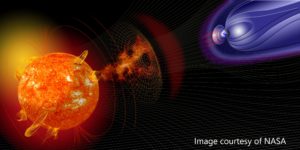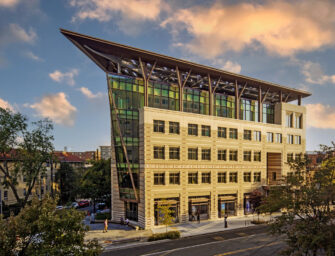Reflections on World Space Week 2017
By Larry Paxton, AGU Space Physics and Aeronomy Section President and Head of Geospace and Earth Science Group at The Johns Hopkins University Applied Physics Laboratory
The human race is beginning to take its first tentative steps off the planet Earth. As we become a spacefaring civilization, we will not only explore space, but we will endeavor to use space, just as we use the resources of earth. We will, I hope, be wise stewards of this new environment.
 The international community established commercial and basic research satellites not only to monitor our planet but also to probe the workings that govern the Earth’s complex systems. The majority of people alive today have never known a time when humans were not capable of space travel. Recently we have seen the nascent beginnings of space tourism, and low-cost technological advances have fueled a “new space revolution” that is both expanding the frontiers of human knowledge while providing far reaching benefits to some of the poorest people on Earth. A moment’s reflection will bring to mind the many ways that the availability of space-based assets affects our lives.
The international community established commercial and basic research satellites not only to monitor our planet but also to probe the workings that govern the Earth’s complex systems. The majority of people alive today have never known a time when humans were not capable of space travel. Recently we have seen the nascent beginnings of space tourism, and low-cost technological advances have fueled a “new space revolution” that is both expanding the frontiers of human knowledge while providing far reaching benefits to some of the poorest people on Earth. A moment’s reflection will bring to mind the many ways that the availability of space-based assets affects our lives.
The AGU’s Space Physics and Aeronomy (SPA) section represents the international community that studies the upper atmosphere (including the mesosphere), the space environment, the Sun’s connection to that environment, and the Sun itself. We often refer to this discipline as “heliophysics.” SPA members are discovering the connections and underlying phenomena that shape our world and that may hold the key to the evolution of other worlds. This new era of discovery of how this complex energy transfer system works, informs our view of the other bodies in the Solar System. We are beginning to discover the ways in which the entire atmosphere, its connection to the surface and to interplanetary space, constitutes a coupled system. With new missions, we hope to better understand these processes. By expanding our understanding, design becomes more cost effective and enables us to operate our satellites and crewed space missions with assurance of success. Future crewed missions to Mars will be enabled by an understanding of the interplanetary radiation environment, its extremes and its predictability.
SPA science is discovery science. One of the fundamental mysteries of our universe will soon be addressed by the Parker Solar Probe; how is the outer atmosphere of the Sun (or any star) heated to temperatures of millions of degrees? We seek to uncover, using our own system as a natural laboratory, how this particular star (our Sun), interacts with a planet (our Earth) at a particular distance with a particular magnetic field strength, orientation, and variability and how this interaction has shaped and continues to shape the habitability of our world. How unique is this particular combination of magnetic field strengths (Sun and Earth), variabilities (solar) and other factors? How have these particulars determined the evolution of life on Earth and our technological civilization? We build our understanding by modeling the processes that shape the space environment and checking that understanding by making measurements. SPA members show great creativity by fashioning instruments to operate on the ground, in aircraft, on balloons, from sounding rockets, commercial sub-orbital platforms, and satellites, large and small.
SPA science is international science. No single nation can, by itself, explore all of these mysteries. This environment is, in many ways, defined by its variability; that variability can range from the benign to the extreme – the latter which is deemed “space weather” (as opposed to the average behavior represented by climatological models). The International Geophysical Year (IGY) from 1957 to 1958 had, as one of its foundational principles, the free availability and exchange of data among all countries. IGY created an appreciation of just how variable ‘space weather’ was. This spirit of collaboration is strong and growing within the SPA section. Collaboration, diversity, acceptance and the open exchange of data are core values of our community.
SPA science can inspire wonder, participation and innovation. Since our field of study is so broad intellectually and spatially, there is great value in any additional data source. A nation taking its first steps into space can make valuable contributions to our understanding, A small college program can build an instrument or even a small spacecraft that can aid in our exploration. By fostering an intellectual spirit that embraces teamwork, diversity and acknowledging the value of the entire range of contributions, SPA can and does inspire and train the next generation of scientists, engineers, managers, and entrepreneurs. The transdisciplinary nature required to explore ‘heliophysics’ operates most effectively in an intellectual climate free of bias and preconceptions As the human race builds more critical infrastructure in space, we grow more dependent on an environment that welcomes the efforts and talents of scientists regardless of national origin.
Declining budgets for basic research have depressed innovation in the SPA community at a time when, paradoxically, we could all benefit from a more robust exploration-oriented science focus. We can’t yet accurately predict the occurrence of extremes in space weather; we may or may not have an accurate characterization of those extremes. The AGU’s SPA section provides a common ground for forming our vision for where our field of inquiry will go. By recognizing the connections between SPA and other AGU sections, as well as SPA and other organizations, we strengthen our community and embrace possibilities presented by new opportunities and new technologies.



There are no comments
Add yours